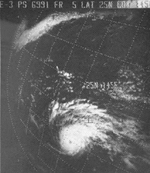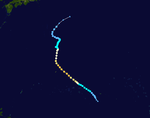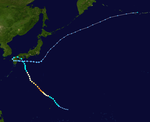1968 Pacific typhoon season
| 1968 Pacific typhoon season | |
|---|---|

Season summary map
|
|
| Seasonal boundaries | |
| First system formed | January 21, 1968 |
| Last system dissipated | November 30, 1968 |
| Strongest storm | |
| Name | Agnes |
| • Maximum winds | 280 km/h (175 mph) |
| • Lowest pressure | 900 hPa (mbar) |
| Seasonal statistics | |
| Total depressions | 39 |
| Total storms | 29 |
| Typhoons | 20 |
| Super typhoons | 4 |
| Total fatalities | Unknown |
| Total damage | Unknown |
| Related articles | |
| Tropical depression (CMA) | |
| Duration | January 21 – January 23 |
|---|---|
| Peak intensity | 55 km/h (35 mph) (10-min) 1002 hPa (mbar) |
| Tropical storm (SSHWS) | |
| Duration | February 28 – March 2 |
|---|---|
| Peak intensity | 65 km/h (40 mph) (1-min) 999 hPa (mbar) |
| Category 4 tropical cyclone (SSHWS) | |
| Duration | April 5 – April 19 |
|---|---|
| Peak intensity | 215 km/h (130 mph) (1-min) 935 hPa (mbar) |
| Category 3 typhoon (SSHWS) | |
| Duration | May 28 – June 5 |
|---|---|
| Peak intensity | 185 km/h (115 mph) (1-min) 950 hPa (mbar) |
| Tropical depression (SSHWS) | |
| Duration | June 2 – June 2 |
|---|---|
| Peak intensity | 45 km/h (30 mph) (1-min) |
| Tropical storm (SSHWS) | |
| Duration | June 4 – June 8 |
|---|---|
| Peak intensity | 65 km/h (40 mph) (1-min) 1002 hPa (mbar) |
| Category 3 typhoon (SSHWS) | |
| Duration | June 26 – July 3 |
|---|---|
| Peak intensity | 205 km/h (125 mph) (1-min) 935 hPa (mbar) |
| Category 4 super typhoon (SSHWS) | |
| Duration | July 19 – August 3 |
|---|---|
| Peak intensity | 240 km/h (150 mph) (1-min) 925 hPa (mbar) |
| Tropical storm (SSHWS) | |
| Duration | July 20 – July 28 |
|---|---|
| Peak intensity | 110 km/h (70 mph) (1-min) 970 hPa (mbar) |
The 1968 Pacific typhoon season has no official bounds; it ran year-round in 1968, but most tropical cyclones tend to form in the northwestern Pacific Ocean between June and December. These dates conventionally delimit the period of each year when most tropical cyclones form in the northwestern Pacific Ocean.
The scope of this article is limited to the Pacific Ocean, north of the equator and west of the international date line. Storms that form east of the date line and north of the equator are called hurricanes; see 1968 Pacific hurricane season. Tropical Storms formed in the entire west pacific basin were assigned a name by the Joint Typhoon Warning Center. Tropical depressions in this basin have the "W" suffix added to their number. Tropical depressions that enter or form in the Philippine area of responsibility are assigned a name by the Philippine Atmospheric, Geophysical and Astronomical Services Administration or PAGASA. This can often result in the same storm having two names.
31 tropical depressions formed this year in the Western Pacific, of which 27 became tropical storms. 20 storms reached typhoon intensity, of which 4 reached super typhoon strength. No storms this season caused significant damage or deaths.
This depression was not recognized by the JMA.
Tropical Storm Polly dropped heavy rains on the southern islands of Japan. 112 people were killed and 21 were missing from the floods and landslides caused by Polly's heavy rains.
On August 18, two sightseeing buses were involved in the landslide in Shirakawa, Gifu, it fell to the Hida River, and 95 persons died and 9 persons became missing(->see the ).
Tropical Storm Trix struck the southern islands of Kyūshū and Shikoku. Heavy flooding killed 25 people and left 2 missing.
Virginia was first noticed near the International Date Line, about 500 kilometers (310 mi) northwest of Midway Islands. The system organized and the first advisory was issued on August 25 at 0006Z, with winds of 35 knots (40 mph). 18 hours later, Virginia crossed the date line, with winds of 50 knots (60 mph). It later became extratropical on August 27 in the Gulf of Alaska.
...
Wikipedia












